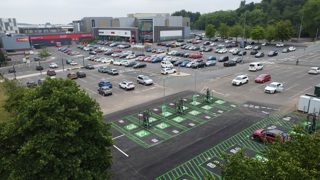By Professor Colin Herron, expert partner at Teletrac Navman
All countries at some point will transfer away from the internal combustion engine (ICE), either by government mandates, or because the vehicle industry is only offering alternatives to an ICE vehicle.
But the efficiency of any transition will be determined by vehicle choice and availability and a sufficient way to fuel or charge them.
Up to now filling a car has been a relatively simple process developed over many years – visit a petrol station, put a nozzle in, fill at a constant rate, then pay and leave in about five to six minutes.
This situation is being replicated for electric vehicles (EVs) but there are differing infrastructure considerations regarding how to get energy, and the right type of energy to where it needs to be.
A big challenge is not a technical one but a behavioural one – how do you convince people to switch to a product which is initially perceived as inferior to the product the person uses and is familiar with. The current population know how far a car goes and it is easy to fill; the first EV models did not go far and were difficult to fill in terms of speed and location.
This has left a lasting impression and poses a real challenge when trying to model what hundreds of millions of people will do 20 to 30 years from now with the options they will have for charging. Some media still report the historical situation as if it were still the case today.
Other factors may also impact behaviours; research suggests that solid state batteries may be commercialised with five-minute charging and 500-mile range, and vehicle makers especially for vans and larger vehicles may offer much cheaper batteries, but they will need charging more frequently.
When modelling how much infrastructure to install there has to be ongoing behavioural monitoring and updating of policy and process – a big task but one that’s currently being looked at using the evolving technology of artificial intelligence (AI).
A major consideration on the installation of infrastructure is the choice of plug: Alternating Current Chargers (AC) and Direct Current Chargers (DC).
A technical point to remember is that a vehicle can be operated by AC but the battery is DC. DC chargers can deliver more power quickly, which enables them to replicate the speed of the fuel pump, which is what the driver is used to.
Whereas the AC charger is slower because it has to go through a conversion in the car into DC and the conversion equipment cost and size currently dictates the maximum power accepted.
The big advantage of AC is that the chargers are much cheaper and you can easily have one at home or on site.
System designers want to make the transition from ICE to EV as easy as possible and as such the fill time becomes the focus in order to achieve parity between the two energy delivery types.
Negative media coverage has stated a driver will have to wait for hours while an ICE takes minutes. This is true on AC chargers, but not DC.
So, charger type aside, a lot of this comes down to policy and the question of how much infrastructure do we actually need.
In China, they are rolling out as many charging points as possible. In certain parts of America, they are rolling out as few as possible.
The fact is, it is not the numbers, it comes down to whether the right chargers by the right type in the right place at the right time are being installed, and that is not happening everywhere at the moment.
It is not enough to measure chargers per 100,000 population, it needs to come down to how those chargers are distributed and a supporting infrastructure is built to accommodate.
For each demographic area there should be a strategy developed based on demand, in other words install the type of charger where there is need based on data.
There is a technique known as geospatial mapping or modelling, which builds a picture of an area based on characteristics.
The Netherlands are a prime example of this where they have a national network of high-power charges, but in the UK, there are around 350 local authorities who do it themselves as does the private sector, meaning a mosaic of activity is happening but is not necessarily delivering what the population needs.
The public funding model has an impact as often grants come with time limits for spending and the desire for numbers of chargers.
This often results in many AC chargers installed in locations that may or may not be of convenience to motorists, and while the private sector is investing in DC chargers and replicating the fuel station, but the two need to come together more.
Fleet operators can address these issues the support of experts who specialise in depots and commercial sites.
Within the arrangement, they will calculate how many chargers are required and by type, what power is needed, take into consideration shifts, and options such as allowing the chargers to be used by a third party when the fleet is out, all power connections, maintenance etc is also included.
This is a specialised job and needs to be undertaken as such with specialists.
In some rare cases it may be a cheaper to actually relocate a depot to where there is a lot of spare power.
Overall, there is an interesting relationship between technology and behaviours; technology creates behaviours but then peoples’ behaviours with technology drives technology change.
At present, infrastructure installation is a complex topic and is being tackled admirably in a number of different ways – but not always the correct way.
What all countries and the private and public sectors need to do is collaborate more and focus on more behavioural data modelling to ensure the right type of infrastructure is going in the right place the first time around, enabling us to transition to a decarbonised future as effectively and efficiently as possible.


















Login to comment
Comments
No comments have been made yet.